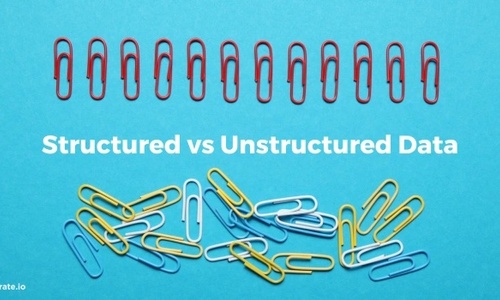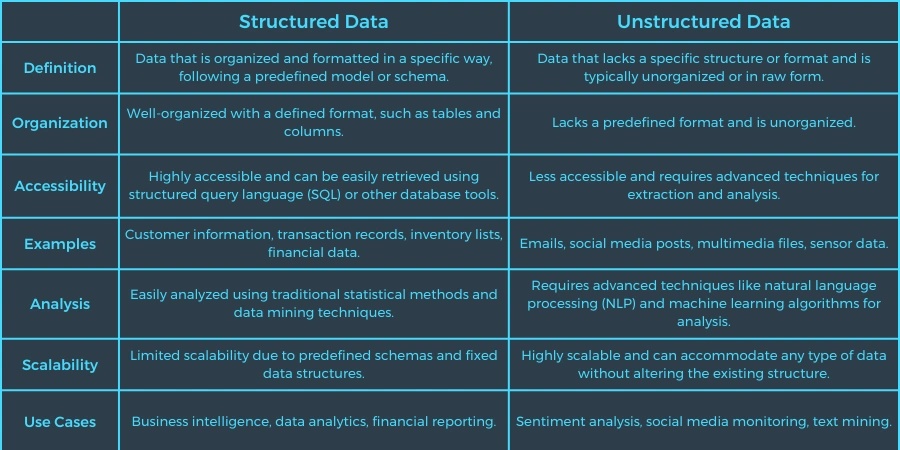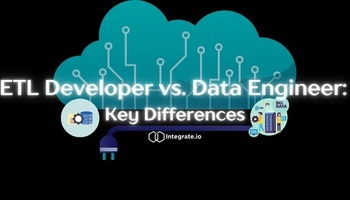Experts predict the big data market will be worth $474 billion by 2030, proving data is incredibly valuable for businesses of all types. However, a company's ability to gather the right data, interpret it, and act on those insights will determine the success of data projects.
The amount of data accessible to companies is increasing, as are the different types of data available. Business data comes in a wide variety of formats, from strictly formed relational databases to social media posts. All of this data, in all its different formats, can be divided into two main categories: structured data and unstructured data.
Here are the key differences between structured and unstructured data:
- Structured data is standardized, clearly defined, and searchable data, while unstructured data is usually stored in its native format.
- Structured data is quantitative, while unstructured data is qualitative.
- Structured data is often stored in data warehouses, while unstructured data is stored in data lakes.
- Structured data is easy to search and analyze, while unstructured data requires more work to process and understand.
- Structured data exists in predefined formats, while unstructured data is in a variety of formats.
Structured data is fairly straightforward to deal with, whereas unstructured data is more complex and harder to organize and extract. In this article, you’ll learn more about these data types and the differences between them.
What Is Structured Data?
The term structured data refers to data that resides in a fixed field within a file or record. Structured data is typically stored in a relational database (RDBMS) and can consist of numbers and text. Sourcing can happen automatically or manually, as long as it's within an RDBMS structure. It depends on the creation of a data model, defining what types of data to include, and how to store and process it.
The programming language used for structured data is SQL (Structured Query Language). Developed by IBM in 1974, SQL handles relational databases and doesn’t require advanced coding skills. Typical examples of structured data are names, addresses, credit card numbers, numerical data, Microsoft Excel files, text files, and so on.
What Is Unstructured Data?
Unstructured data is more or less all the data that is not structured. Even though unstructured data may have a native, internal structure, it's not structured in a predefined way. There is no data model; the data is stored in its native format.
Typical examples of unstructured data are rich media, text, social media activity, video files, audio files, surveillance imagery, and various other file formats.
The amount of unstructured data is much larger than that of structured data. Unstructured data makes up a whopping 80% or more of all enterprise data, and the percentage keeps growing. This means that companies not taking unstructured data into account are missing out on a lot of valuable business intelligence.
What Is Semistructured Data?
Semistructured data is a third category that falls somewhere between the other two. It's a type of structured data that does not fit into the formal structure of a relational database. But while not matching the description of structured data entirely, it still employs tagging systems and other identifiable markers, separating different elements and enabling search. Sometimes, unstructured data is known as data with a self-describing structure.
Smartphone photos are a typical example of semistructured data. Every photo taken with a smartphone contains unstructured image content as well as the tagged time, location, and other identifiable (and structured) information. Semi-structured data formats include JSON, CSV, and XML file types.
Side by Side Comparison of Structured vs Unstructured Data
Structured vs. Unstructured Data: 5 Key Differences
Here are the five main differences between structured vs. unstructured data:
Defined vs. Undefined Data
Structured data is clearly defined data in a structure. While unstructured data is usually stored in its native format, structured data lives in rows and columns and can be mapped into predefined fields.
Unlike structured data, which you can organize and access in relational databases, unstructured data does not have a predefined data model and is undefined.
Qualitative vs. Quantitative Data
Another difference between structured and unstructured data is that structured data is often quantitative data, meaning it usually consists of hard numbers or things that can be counted. (For example, product information in a customer relationship management system, or CRM.) Methods for analysis include regression (to predict relationships between variables), classification (to estimate probability), and clustering of data (based on different attributes). Data scientists and other data analysts can use these methods to generate business insights for your organization.
Unstructured data, on the other hand, is often categorized as qualitative data and cannot be processed and analyzed using conventional tools and methods. In a business context, qualitative data can, for example, come from customer surveys, interviews, and social media interactions. Extracting insights from qualitative data requires advanced analytics techniques like data mining and data stacking.
Data Storage in Data Warehouses vs. Data Lakes
Businesses often store structured data in data warehouses and unstructured data in data lakes. A data warehouse is an endpoint for the data’s journey through an ETL pipeline. A data lake, on the other hand, is a sort of almost limitless repository where you store data in its original format or after undergoing a basic “cleaning” process.
Both structured and unstructured data have the potential for cloud use. Structured data requires less storage space, while unstructured data requires more.
As for databases, structured data is usually stored in a relational database, while the best fit for unstructured data instead is so-called non-relational, or NoSQL, databases.
Ease of Analysis
One of the most significant differences between structured and unstructured data is how well-structured data lends itself to analysis. Structured data is easy to search, both for data analytics experts and for algorithms. Unstructured data, on the other hand, is intrinsically more difficult to search and requires processing to become understandable.
While there are a wide array of sophisticated analytics tools for structured data, most analytical tools such as natural language processing (NLP) and machine learning algorithms (ML) for mining and arranging unstructured data are still in the development phase.
Predefined Format vs. Variety of Formats
The most common format for structured data is text and numbers. Structured data has been defined beforehand in a data model.
Unstructured data, on the other hand, comes in a variety of shapes and sizes. It can consist of everything from audio, video, and imagery to email and sensor data. There is no data model for the unstructured data; you store it natively or in a data lake that doesn't require any transformation.
Why You Should Manage Your Unstructured Data
Most businesses keep a backup of their data. However, current estimates show that business-related data increases every year, making data storage a challenge. Most business data is "cool" data (data that has not been accessed for 30 days), which clogs up expensive hard drives and increases storage costs.
Most companies struggle to manage unstructured data, in particular. This is because unstructured data is difficult to index, and XML, key-value, and JSON databases are not designed to analyze such data. The process of extracting, analyzing, and processing unstructured data is usually outsourced to a secondary system. Moving data around takes up even more storage, which isn’t financially sensible.
Some companies choose not to manage unstructured data at all. Instead, they expand the capacity of primary storage systems. But this method is problematic and comes at a cost, as you can see below:
- First, unstructured data consumes primary storage; there is no room for data of any other kind. Primary storage can be the most expensive because it usually requires expensive flash drives.
- Second, businesses must refresh storage infrastructure every three to five years and include all of their cool unstructured data in this process. Businesses also need to consider migration costs and the secondary storage required to support backups.
- Third, global data governance laws require firms to know exactly what is being held within their unstructured data and whether it contains personally identifiable information.
Optimizing performance and lowering costs is possible if you manage unstructured data efficiently. Opting for a cloud, tape, or secondary storage solution makes managing unstructured data easier.
Final Word
There are mainly two categories of data: structured data and unstructured. Structured data (names, addresses, credit card numbers, etc.) resides in predefined models and formats, while unstructured data (audio, video, surveillance data, etc.) is stored in its native format until it's extracted for analysis. There is also semistructured data; a category that falls between the other two. It refers to data that has some kind of tagging structure but still doesn't fit into the formal structure of a relational database.
In this article, we've looked at five important differences between structured and unstructured data:
- Defined vs Undefined Data
- Qualitative vs Quantitative Data
- Storage in Data Houses vs Data Lakes
- Easy vs Hard to Analyze
- Predefined Format vs a Variety of Formats
While structured data is much easier for Big Data programs to process, it's paramount not to forget about unstructured and semistructured data. Analyzing unstructured data does present a more significant challenge. But considering that more than 80% of all enterprise data adheres to this category, and is growing at a rate of 55% - 65% per year, leaving it out will create large blind spots. Luckily, as technology evolves, the insights that are hidden in unstructured data are becoming more accessible.
In this article, you learned five important differences between structured vs. unstructured data. In summary, structured data (names, addresses, credit card numbers, etc.) resides in predefined models and formats, while unstructured data (audio, video, surveillance data, etc.) is stored in its native format until it's extracted for analysis. There is also semistructured data, a category that falls between the other two. It refers to data that has some kind of tagging structure but still doesn't fit into the formal structure of a relational database.
How Integrate.io Can Help With Structured Data vs. Unstructured Data
Integrate.io believes everyone should be able to manage their data, regardless of their coding and data engineering experience. This no-code data pipeline platform makes it easy to move structured, unstructured, and semi-structured data to a central repository like a data warehouse or lake without the heavy lifting.
Integrate.io offers a complete toolkit for building ETL, ELT, ReverseETL, and CDC pipelines, making it easy to source data, transform it into the correct format, and move it to your desired location.
With Integrate.io's workflow engine, you can orchestrate and schedule data pipelines that move structured and unstructured data to a location based on your business requirements. With rich expression language, you can implement complex data preparation functions and integrate them with other data repositories and applications.
Other benefits of Integrate.io include:
- World-class customer service
- Online support
- Build custom connectors via REST API
Are you ready to learn how Integrate.io can help you manage and integrate structured and unstructured data? Schedule a demo now and move different data types from data sources without advanced code or data engineering.
FAQ
What are structured and unstructured data?
Structured data is standardized, searchable, and often stored in relational databases, while unstructured data is stored in its native format, requiring more effort to process and understand.
How is structured data different from unstructured data in terms of analysis?
Structured data is easy to search and analyze using standard methods, while unstructured data requires advanced analytics techniques to process and extract insights.
Where are structured and unstructured data typically stored?
Structured data is usually stored in data warehouses, whereas unstructured data is stored in data lakes.
What is the significance of managing unstructured data for businesses?
Managing unstructured data allows businesses to tap into a vast amount of information for insights, making it crucial for informed decision-making and maintaining a competitive edge.
How can Integrate.io assist businesses with structured and unstructured data?
Integrate.io offers a no-code platform for moving both types of data to a central repository, simplifying the management and integration of data without the need for advanced coding skills.











